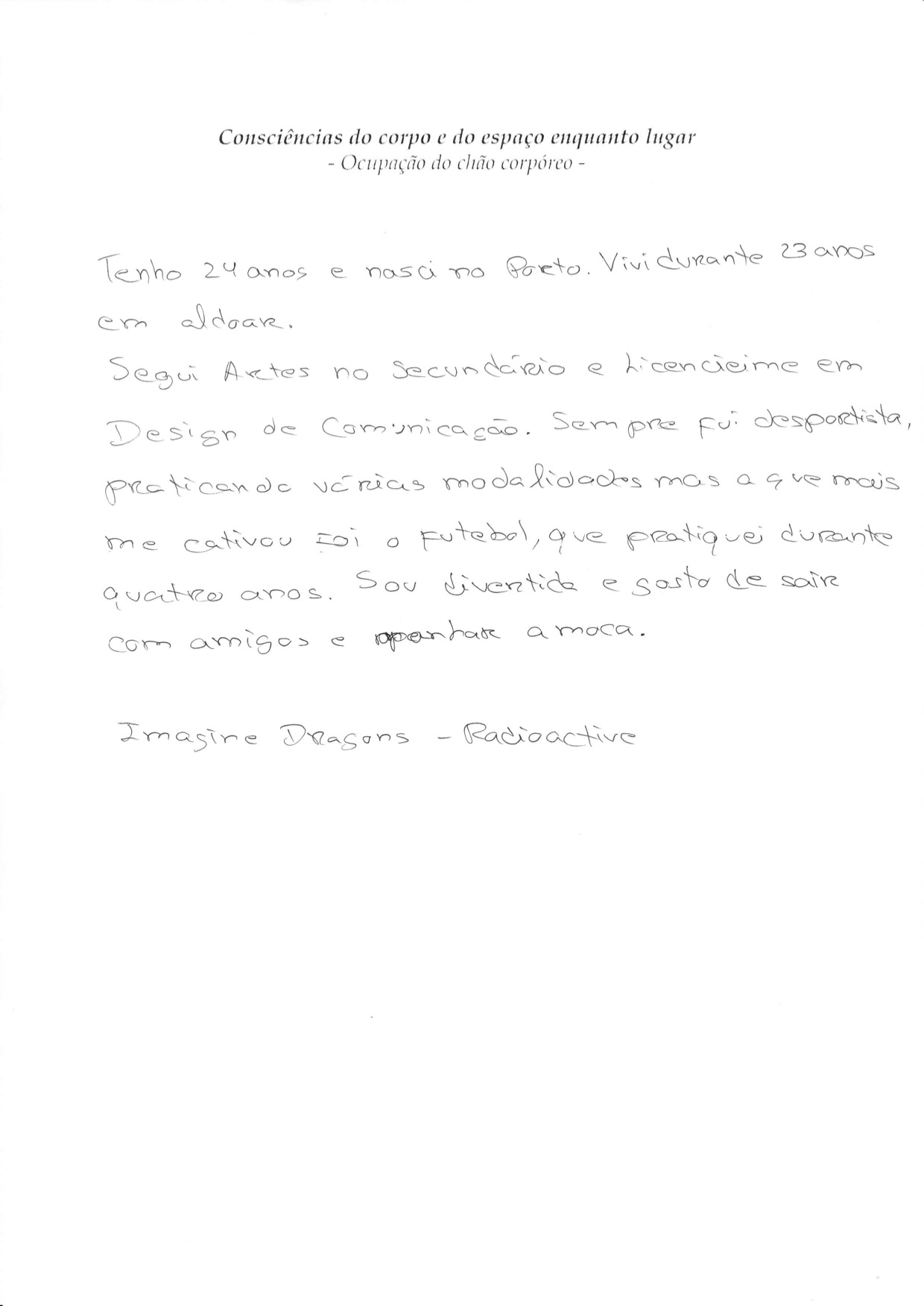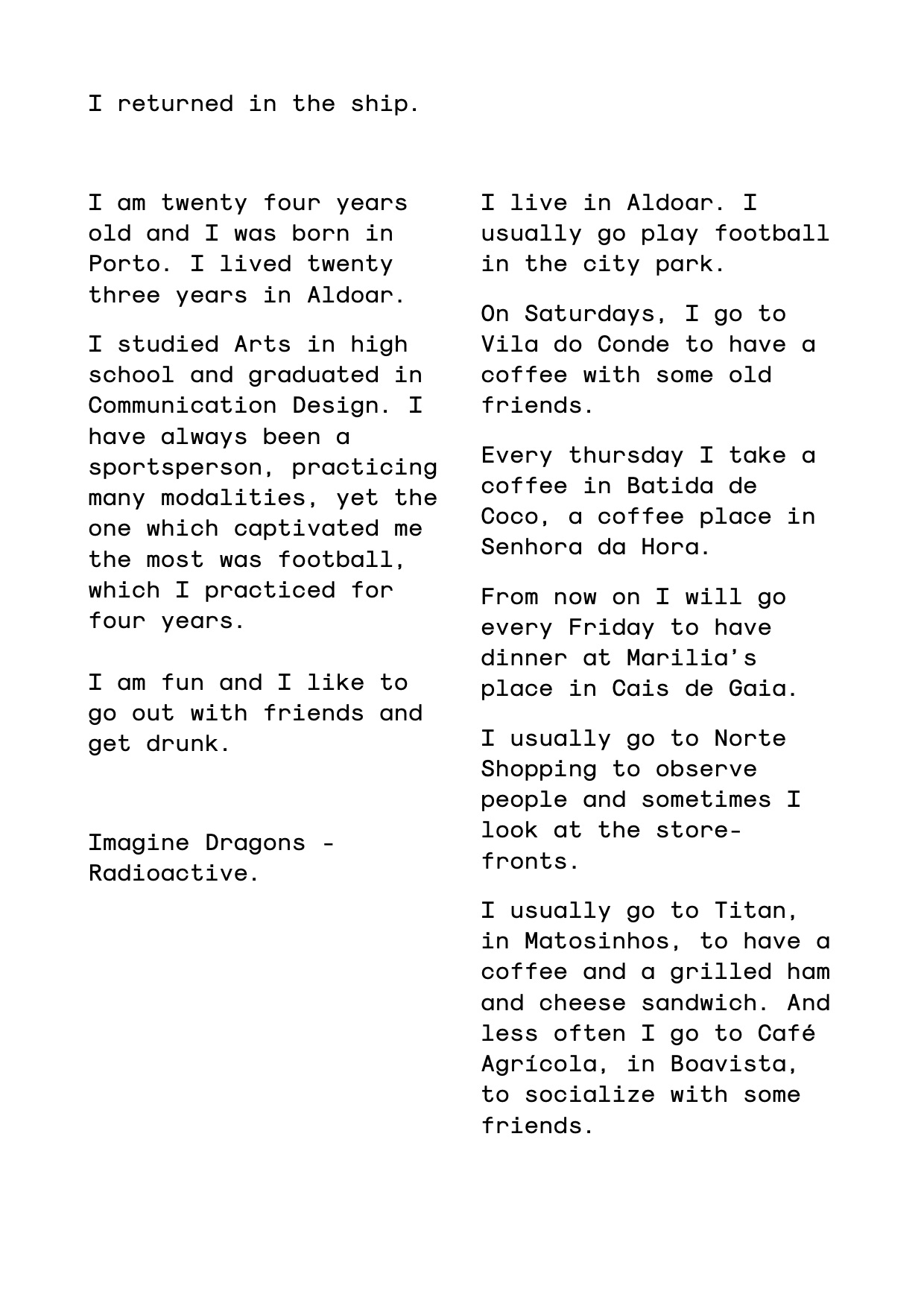OCCUPATION OF THE CORPOREAL FLOOR — THE CONCIOUSNESS OF THE BIOGRAPHIC SPACE 2
2014Video, 5:03
MA Project: Faculty of Fine Arts of Porto’s University
Author: Marília Ribeiro (PT)
Supervisor: Paulo Luís Almeida (PT)
Performer: Inês Nêves (PT)
Choreographer: Inês Nêves (PT) and Cláudia Eiras (PT)
“Occupation of the corporeal floor explores strategies for visual representation of the
relationship between the body and the lived space.
Faced with the problem of space representation and in its relationship with the
own body, a need was created to equate this relationship in a less literal way,
purely based on biographical grounds. (...) The body-space relationship is triggered in two stages: firstly, protocol, reflects the
mental image that four individuals have of their biographical space, whereby map
is used as the recording of the space as a statement of the action. Secondly,
performative character, is based on the background images and descriptions, and
inscribed it on new meanings through drawings and choreographic movements
traced on the ground.”1
“Drawings of maps and choreography are understood as performances, where it becomes possible to visualize the maps drawn by the movements of the body. It is intended that the explored relationship between body and biographical space enables new ways of understanding, by seeing them as an indissoluble unity and not as two articulated realities. (...) In a broader sense, these maps document people interacting with their environments and mapping this same interaction. The map is understood as a visualization of a lived experience, but also as a notation for the movement. The biographical space results from the construction of an awareness of the body and map, because there is a demand of space itself in the body.”2
“Drawings of maps and choreography are understood as performances, where it becomes possible to visualize the maps drawn by the movements of the body. It is intended that the explored relationship between body and biographical space enables new ways of understanding, by seeing them as an indissoluble unity and not as two articulated realities. (...) In a broader sense, these maps document people interacting with their environments and mapping this same interaction. The map is understood as a visualization of a lived experience, but also as a notation for the movement. The biographical space results from the construction of an awareness of the body and map, because there is a demand of space itself in the body.”2
1 Marília Ribeiro, summary to Ocupação do Chão Corpóreo (Faculdade de Belas Artes da Universidade do Porto: 2014), 63.
2 Ibid., 63.
2 Ibid., 63.
PHASE ONE: Lídia Azevedo’s biographic text
“The series of four performances named The Consciousness of the Biographic Space was prepared according to the movement specifications of each solo, taking into account the biographic text delivered to the performers and the personality of each individual under study.”3
3 Marília Ribeiro, Ocupação do Chão Corpóreo (Faculdade de Belas Artes da Universidade do Porto: 2014), 47.
4 Ibid.
3 Marília Ribeiro, Ocupação do Chão Corpóreo (Faculdade de Belas Artes da Universidade do Porto: 2014), 47.
4 Ibid.
The Consciousness of the Biographic Space 2 explores Lídia Azevedo‘s biographic space. The biographic text was interpreted in keywords, which were then reflected upon and communicated through choreography. “(...) it explores <<stretching>> and <<twisting>> as movement qualities, using the whole body even though the arms and legs follow different directions, identifying communication and ponderation as keywords for the personality of the individual under exploration.”2




PHASE TWO: Lídia Azevedo’s biographic space


“The movements are recorded and the marks are read as testimony to a sequence of steps, a path. The marks generated by the movements as a result of a process of walking and dancing are not exact geographic locations, but interpretations of a space used by the body itself, so it is obvious that some sections of the route drawn and recorded on video produce marks with traces and distinct forces.
These drawings can be understood as constituting notations, but notations created spontaneously: the route is mapped, but not using the predetermined cartographic notation to describe the territory. Instead, the path generates it and creates its own representation in the dance. As well, the role of the interpreters is that of an intermediary that facilitates the translation of the visible environment in the drawing to the marks registered by the movement in the performances.”5
5 Ribeiro, Ocupação (2014), 53.


